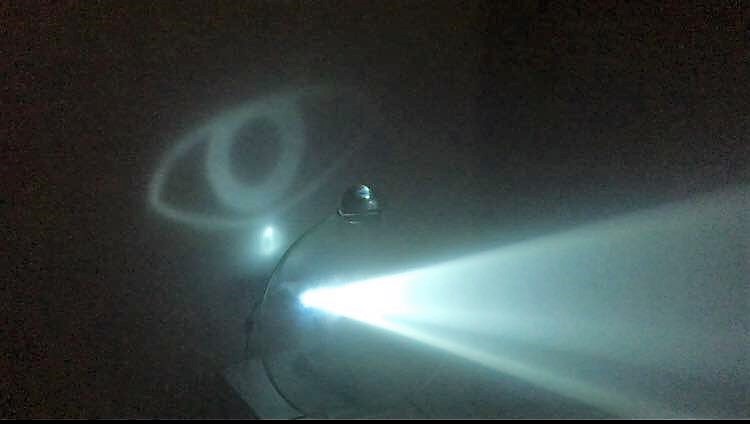
Photos by Ariana Gastelum.
Everything was black. I gripped tightly to the rope hanging in front of me as I waited in anticipation for the unknown.
Suddenly, a faint buzz sounded into my ear. I loosened my firm hold and surrendered my racing thoughts to the sound. It travelled from one ear to the other, until it transformed into something else…rain falling, bells ringing, a plane landing, mosquitoes humming, a door opening.
I carefully followed the web of knotted rope as my mind journeyed down the rabbit hole with little care about where I was going and who was watching me.
“Drift,” an installation by Margaret Noble, provides an experience of dissociative roaming between real and simulated stimuli. For up to four minutes, the participant is blindfolded, subjected to headphones with surround sound and immersed into an environment made up of ropes, which they could follow and move under.
Every individual’s response to the sounds is different. Some move throughout the installation, and others remain stationed.
One man moved quickly and drastically while he participated, Noble told the Post. Another woman started singing.
“Drift” was one of the more than 50 exhibits, presentations and performances featured in Public Urban Multi-Sensory Presentations (PUMP), purposed to function as a conduit of multi-sensory experiences that communities have the opportunity to encounter, and each individual experience is unique.
The opening receptions that took place Saturday occupied three venues: The Ice House, The Packard and Co-Op Gallery.
The Ice House

Three giant tongues hung over a doorway near the entrance of The Ice House. A white wall nearby was decorated with incomplete short poems and markers provided for viewers to complete them. A few read:
“The heart cracked open like a…watermelon.”
“All the crazy brain chatter is like…a figment of my dog’s imagination.”
“Cradling the water of the world, as if this moment is…all there has ever been or all that ever will be.”
In every head turn, there was something extraordinary to see, hear or touch.
Approximately 20 people gathered to watch artist Takeshi Kanemura wrap three volunteers in plastic sheets and packing tape, only to cut the materials away, piece by piece, to create a sculpture made of the remnants.
Downstairs, “3 Below: The Basement,” was a space with 21 wide, pyramid-shaped columns, white walls with random dark holes and a creepy hidden crevice. The room had both tones and rushing sounds resonating throughout, encouraging those who entered to find a sound, follow it and add their own.
Outside, people found themselves hypnotized during “Express Conduit Transmissions” by Radio Machine Magazine. The installation presented a screen projecting red and blue abstract images that flashed like lightning. Touch-sensitive metal handles triggered the model pyramids on both sides of the screen to glow, a vibration that traveled throughout the body, along with a loud, deep hum that eliminated any outside sounds. Once activated, it took a conscious effort to leave its hypnotic state.
The Packard

Sound art by phog masheeen promoted a dark introspection triggered by a trance of lasers cutting through dense fog using a combination of experimental sounds and electronic rhythms.
Numerous large installations filled the rooms of The Packard including pairs of legs constructed within a net, hanging bell-shaped figures and steel spirals.
One small room was left empty with a headset for viewers to experience artist Andy Fedak’s interactive virtual reality. In this case, it takes you to the other PUMP venue.
“I believe this is the basement of The Ice House,” Afsaneh Assadi, wife to Kamran Assadi, founder of FLOOD, Inc. and the team behind PUMP, told the Post while wearing the headset. “It’s marked with glass squares, but it’s not glass. It’s for me to be aware that I can’t walk through because there is a wall […]. This is so awesome.”
Another room was entirely covered with more than 4,000 shipping tags inscribed with memories from people of all ages from all over the world. Some were described in words and others were expressed through pictures. Blank tags decorated the ceiling in swirls to mimic the swirling forms of the brain. This installation by Gretchen Potts is called, “Wallpaper for the Mind.”
Co-Op Gallery

Urban canopies decorated with silhouettes of leaves and branches blanketed the ceiling of the exhibition. A small black pool surrounded by eggshells laid in the center of the room. While looking into it, one could see her or his reflection immersed with the illustrations hanging above.
Fifteen two-by-four lumber, ranging from eight feet to three feet in height, hung near the entrance along with tools for the audience to play the blocks like a xylophone. Others climbed, hanged and drummed on the wooden structure nearby.
The walls were decorated with various tree-themed portraits in a variety of styles. The majority of those in the hallway featured a never-ending forest of harsh, black brushstrokes. In other pieces, pine trees harmonized with architecturally-inspired designs.
“TIMBER/TIMBRE,” an interactive, visual and sound installation by Jennifer Gunlock, Hilary Norcliffe and Katie Stubblefield, is designed for viewers to contemplate their relationship with the environment.
PUMP is free to the public and will be open until October 21. Learn more about PUMP through its website here.
{gallery}asia/arianapump{/gallery}

